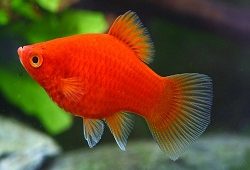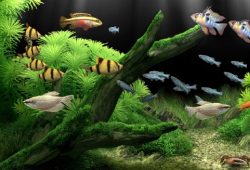Best Peaceful Tangs
In the article it is spoken in detail about Best Peaceful Tangs. While many tangs are aggressive, these five are the peaceful tangs. Big and beautiful, these are not beginner fishes, but they are amazing saltwater species.

If you have a tank that is over 75 gallons, you may want to consider one of the tangs discussed in this article. Tangs, often called surgeonfish, are active, interesting, colorful, and long-lived. In addition, many are outstanding algae-grazers. Although some are quite aggressive, the ones discussed here are peaceful, although they are probably not the tangs the beginning aquarist should consider.
Contents
A Warning
Tangs derive their family name from the Greek meaning “thorn tail,” and the aquarist should take note of this fact, as tangs have a scalpel-sharp retractable blade on each side of their tail. Be cautious when handling a tang!
General Care
While most tangs are listed as herbivores, the reality is that most saltwater fishes are omnivores. Even algae-grazers like tangs ingest a fair amount of micro-animals living in the algae they eat. In the aquarium, tangs do quite well on a diet of dried marine algae (Nori), Spirulina Flakes, and frozen mysis shrimp. It’s best to soak flake food in some type of vitamin supplement (e.g. Selcon) in order to help the fish fight off any possible parasite infestations.
Tangs need swimming space, and so the aquarium should be aquascaped with this in mind. While some tangs (like the ones you may have seen at the local fish store) do well in shoals as juveniles, it’s best to only house one member of a tang species in your aquarium. Also, it is best to avoid keeping multiple species of tangs if those species are similar in shape or coloration.
Five Great, Peaceful Tangs for the Intermediate Aquarist
From smallest to largest, here are five fantastic, peaceful tangs for your saltwater aquarium.
Blue Tang (Paracanthurus hepatus)
This is a fantastic fish—beautifully colored, but with a reputation for being difficult to keep. Often called the palette surgeonfish, the hepatus tang, the regal tang, or the Blue Hippo Tang, this fish may grow to about a foot in length and needs at least a 75-gallon aquarium. An omnivore frequently collected from Fiji, the Solomon Islands, and Hawaii, juveniles adjust most readily to captivity. This is a tang that especially appreciates plankton and meaty foods, as does the:
Yellow Belly Blue Tang (Paracanthurus hepatus)
As you can see from the scientific name, this is the same species as the blue tang—just a different color morph from the Indian Ocean. If you think the blue tang is beautiful, you’ll be blown away by this fish. In every other way, it is a blue tang, and will remain half a foot smaller than the:
Blonde Naso Tang (Naso elegans)
The blonde naso tang, also called the orangespine unicornfish, lipstick tang, or tricolor tang is an awesome fish—very peaceful and beautifully colored. Males have streamers (although they don’t show until the fish is in the 6–9 inch range. Because this fish may reach 18 inches in length, it needs an aquarium of at least 150 gallons, preferably with a length of four feet (to provide swimming room). This fish is collected from the Indian Ocean unlike its cousin frequently collected from Hawaii, the:
Naso Tang (Naso lituratus)
Also potentially reaching 18 inches, the Naso Tang is nearly identical to the Blonde Naso Tang except for coloration. Although frequently collected from Hawaii, this fish is also collected from Japan, Australia and Tahiti. Juveniles and adults are beautiful, unlike the:
Vlamingii Tang (Naso vlamingii)
The vlamingii tang, while somewhat drab-looking as a juvenile, is a stunning (albeit large) tang. Potentially growing to almost two feet in length, this Indo-Pacific fish needs space. Don’t even think about keeping this fish in less than 150 gallons, and be sure the tank is at least four feet long. Males, like the naso tangs, will grow beautiful streamers. Be especially careful when handling this fish. Care should be taken when handling this fish given that its caudal peduncle is very sharp. It’s best to not net this fish as the caudal peduncle and the horn can be easily tangled in nets—use a cup or bucket.
There you have it–five peaceful, beautiful tangs. Choose Wisely!



